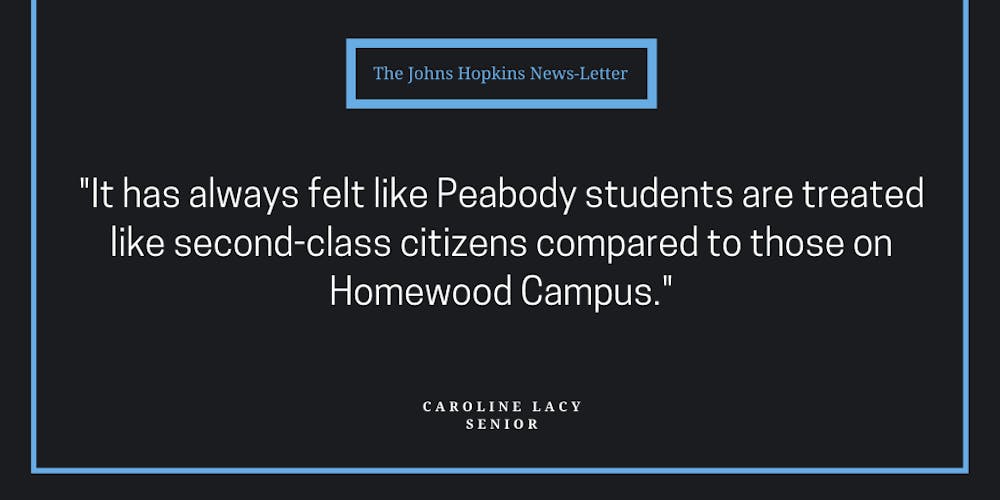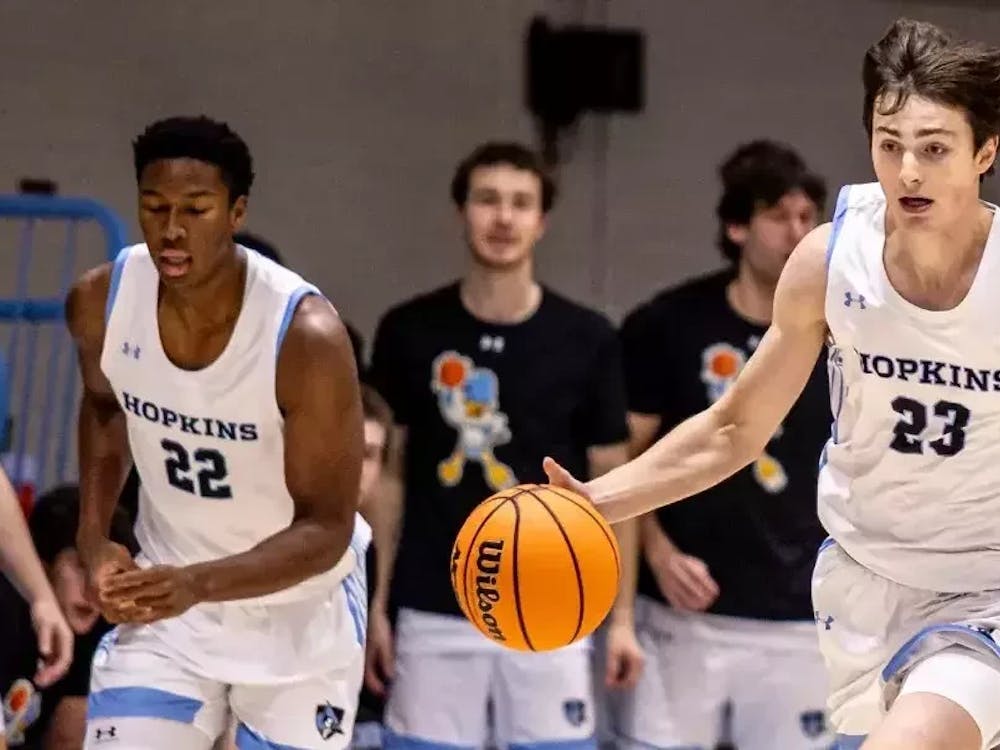Though just over two miles apart, the Homewood and Mt. Vernon campuses feel vastly different. Students at the Peabody Institute describe feeling like an afterthought of the University, with unreliable transportation and limited student facilities. In interviews with The News-Letter, students detailed their experiences this past semester.
Forgotten campus
Students described the various challenges they’ve experienced at Peabody,
Senior Caroline Lacy, a Peabody and Homewood dual degree student, asserted that the University should direct more attention and support towards the Peabody Institute.
“It has always felt like Peabody students are treated like second-class citizens compared to those on Homewood Campus,” she said.
Lacy recalled that she and other students had communicated with the University administration about the 23 credits per semester limit the University previously tried to set on dual degree students. She stated that the cap made it impossible for students to graduate on time.
“It just goes to show that the administration gives so little thought to Peabody that they genuinely did not understand why this was a problem because they did not know the credit amounts required for an average Peabody semester,” Lacy said.
In an email to The News-Letter, sophomore Jordan Amato agreed that the University remains inconsiderate of dual degree students. She contacted the University administration last semester about harsher COVID-19 regulations for Peabody students, which made it difficult for first-year dual degree students to be part of both Peabody and Homewood communities. She was disappointed with its lack of action afterward.
In an email to The News-Letter, Director of Media Relations Jill Rosen acknowledged the importance of student life at Peabody and stated that the University is working with partners to improve the student experience.
“Peabody is creating a campus master plan, looking holistically at student life needs including campus living, dining and overall programmatic space,” she wrote.
Lacy also raised to question the fact that many student resources such as the Student Health and Wellness Center and the Rec Center only exist at the Homewood Campus and that there are no adequate substitutes at the Peabody campus.
Rosen replied that the University has recently relocated Peabody’s fitness center to a larger and more convenient space, and renovations including new equipment are planned. She added that the expanded Ralph S. O’Connor Center for Recreation and Well-Being at Homewood is also free to Peabody students, as well as a number of virtual services to make Homewood’s facilities more accessible to students on other campuses.
In regards to health facilities, she explained that the Student Health and Wellness Center provides tele-medicine appointments depending on the nature of concern. The Homewood Counseling Center conducts initial consultations virtually and offers both in-person and teletherapy appointments. Rosen also encouraged Peabody students to utilize virtual services such as TimelyCare and SilverCloud.
Transportation
Students at Peabody can take classes and join student organizations at Homewood and, in part due to lack of comparable facilities in Mt. Vernon, all Peabody students need access to the Homewood campus. When issues occur with the Johns Hopkins Medical Institute (JHMI) Shuttle connecting the Homewood, Peabody and med campuses, Peabody students feel the impact.
Lacy allocates at least half an hour between Peabody and Homewood classes to make sure that she has enough time to make the trip.
“The biggest problem for me has been the bus system, which I — along with many others — heavily rely on to get to classes and rehearsals,” she said. “Due to the inconsistency of the bus schedule, I am often late or forced to spend my own money to take a scooter or an Uber to class.”
Amato similarly expressed frustration with the shuttle’s inconsistent hours, noting the stress it added to her daily life.
“Given that dual-degree students typically take 25 credits per semester, I can tell you that we don’t have the time to be inconvenienced by transportation,” she wrote. “There still aren’t enough buses, and the bus drivers don’t follow the schedule perfectly. In an ideal world, buses would come every ten minutes.”
Sophomore Tong Wu, also a dual degree student, agreed that the sporadic arrival of shuttles can cause headaches. Wu mentioned using the Charm City Circulator Purple Route as an alternative.
Rosen explained that the current JHMI Shuttle schedule is almost identical to pre-pandemic schedules with a comparable number of total trips. She added that the Blue Jay Shuttle Night Ride service had merged service areas for Homewood and Peabody during the pandemic and that the University plans to keep them merged so that Peabody students have an additional way to travel to and from Homewood in the evenings.
Dining & Facilities
Students additionally reported unsatisfactory food as part of their concerns. Wu and many students agreed that they were dissatisfied with the lack of variety of the food provided in comparison to the Fresh Food Cafe (FFC) and Nolan’s, located on the Homewood Campus.
“There are much fewer options in terms of desserts, fruits and what’s offered at the salad bar. There’s also no wok station at Peabody. However, sometimes Peabody offers really great food, even better than Nolan’s or FFC,” he said. “Generally, I would say the quality of the food is quite unstable.”
Amato explained that she ends up eating the same three meals almost every day.
“It’s generally hamburger or green-looking chicken and fries, salad and either spicy or bland beans with rice,“ she wrote. “A lot of my friends have stopped eating at the Peabody Cafe, and almost always eat at FFC or Nolans instead. It’s not necessarily because [our] food is worse quality, but instead that there are far less options.”
In response, Rosen stated that the University continues to work with the dining vendor Bon Appetit to create more menu options at Peabody and provide students with flexibility to meet their dietary needs.
“This spring there will be a seasonal refresh of the menus. Dining Services is also collaborating with Peabody on the master plan. With the transition to self-operated dining services, we continue to improve the overall dining program, including an enhanced focus on culinary innovation and sustainability,” she wrote.
Ashleigh Edwards contributed reporting to this article.





